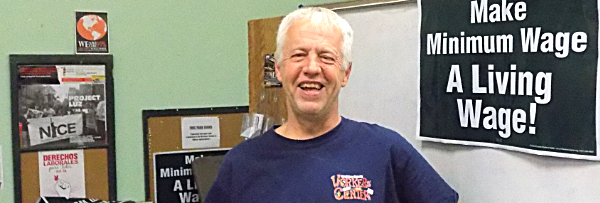- By Dan Veaner
- Business & Technology
 Print
Print  Tompkins County Worker Center Coordinator Pete Meyers
Tompkins County Worker Center Coordinator Pete MeyersIn a perfect world all workers would earn a minimum of the cost of living, right? And all employers would be able to afford to pay that amount or more. But employers worry that higher wages makes their businesses less competitive, and not all small business owners can afford employees, even at the minimum wage. Is a living wage feasible? One way to find out is to ask people across the whole spectrum of workers and employers. That is exactly what the Tompkins County Minimum Wage Working Group is doing in a series of information gathering sessions.
A session Saturday at the Dryden Community Café asked workers what they think about the issue. In a session moderated by Tompkins County Workers' Center Coordinator Pete Meyers, workers were asked five questions about the positive and negative effects of their households earning a living wage would bring, how it would impact family planning for the future; how it would impact the quality of their work and the byproduct of that work; and other impacts if Tompkins County were to require a local minimum wage that would, presumably, be higher than that imposed by New York State.
"The median wage in Tompkins County is the second highest in the state of New York and one of the highest in the northeast," Myers says. "It's only a dollar an hour less than New York City. Median wage has something to do with how well an area can handle a wage increase. So there's money here. I think it matters what kind of business we're talking about. I think some businesses here could handle a wage increase, and the customer base could handle that."
But smaller mom and pop businesses might find it harder to survive, and workers would be in the same boat. According to the latest Alternatives Federal Credit union living wage study, released in 2017, a single person working full time would have to make $13.90 per hour 40 hours a week, for a total of $28,911.84 a year. But Myers says that New York State is raising the minimum wage to $12.50 over the next few years.
"NYC, Long Island and Westchester are going to $15, and upstate is going to $12.50," he says. "By the time it gets phased in the living wage here will be $17.50."
The working group is made up of local officials ranging from local government officials to the President of the Tompkins County Chamber of Commerce. While this county leans toward the liberal, the group is diverse enough to include differing points of view. Myers says information sessions like the one Saturday will target different stakeholder groups. The first was for caregiver non-profits. Saturday's was for workers. The next session will target governments and school districts, and another future session will focus on large employers.
Employers will be asked about the impacts to their businesses, including how they would plan their businesses differently, and positive and negative impacts a local minimum wage would have on them.
The information sessions are the first stage in a study that will be conducted by Cornell's Industrial Labor Relations (ILR) School. The study will seek to quantify the challenges and benefits of requiring a county-wide minimum wage that matches the living wage.
"There are certain challenges we learned about Saturday with the worker population, as opposed to the employer population," Myers says. "When we do the information sessions for employers they are all being paid to be there. That's not the case with workers, who are oftentimes working more than we would want them to be working, which is why we're doing the campaign."
Myers says the information gathering sessions will likely continue until mid-fall, many of them moderated by Franziska Racker Centers Executive Director Dan Brown. Once completed, a larger study will be commenced at the ILR School. A final report will inform the Legislature, with an analysis of quantitative data, and determining how real challenges to requiring a living wage actually are. After that he hopes the Legislature will enact a local minimum wage in similar fashion to Seattle, which increased its minimum wage to $15 per hour this year, an update to its 2015 Minimum Wage Ordinance Minimum Wage Ordinance.
"It's an intriguing process," Myers says. "I would bet in the big cities where this has taken place they haven't done this amount of research in advance. The County Legislature, in terms of principal, we would win this tomorrow. They don't want to do something that will end up hurting us. To be clear, our intention is to have legislation passed," he says. "I don't talk about if this wins... I talk about when it wins. Am I going to bet my life that it will? No. But we're acting as if it will."
v14i30




